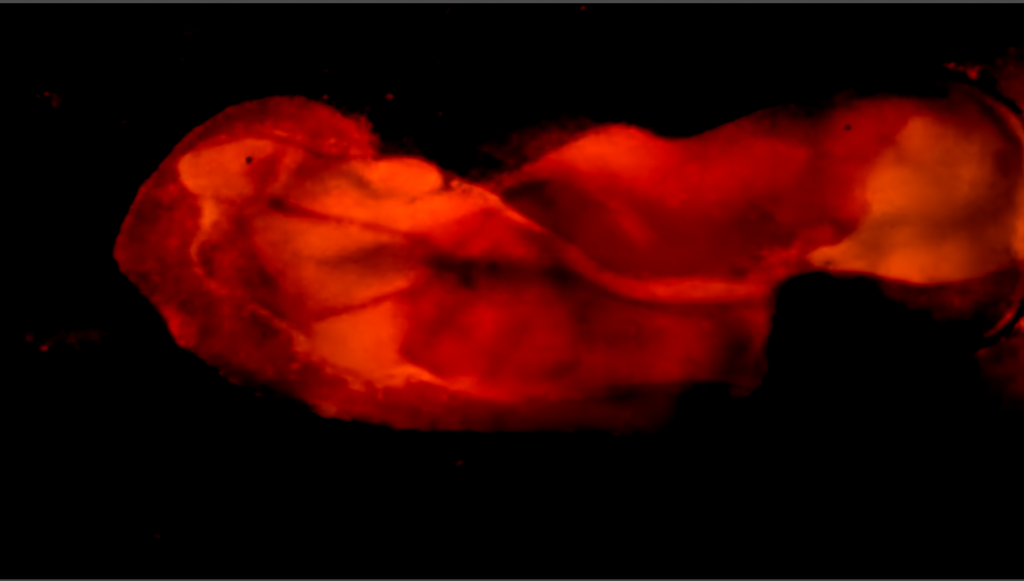
AT/CAN 2021, col, 7 min
music: Sophie Trudeau, soundmix: Timothy Herzog, supported by: iff Innovative Film Austria, Wien Kultur, produced by: Michaela Grill, Sophie Trudeau, distribution: sixpackfilm
Among the arguments made in favor of cinema as a source of scientific knowledge, the most obvious one right from the start was that film not only records movement, but in many cases makes it perceptible in the first place. Magnification reveals cellular processes; time-lapse and slow-motion effects bring the bursting of pollen and sprouting of flowers up to the scale of human perception. In under the microscope, these and other famous motifs from the history of science films make their appearance. Just as often, however, it is hard to determine just what is pulsating, bursting, or proliferating in the picture. In her glittering remontage of science films from the 1920s, Michaela Grill does not spread out catalogues of motifs, but aims straight at the fascination of these recordings: their value as educational material was never neatly separated from their aesthetic appeal as a pure cinematic spectacle. Discrete forms begin to swarm; seemingly motionless things break out into choreographies. Found nature and technical image processes dance closely entwined. Grill uncovers these visual events and explores their cinematic value through color transformations loosely based on historical tinting, through cross-fading and cutting heightened to a point of flickering staccato, through rhythmic editing of image detail and the speed of movement. In the same way, in the course of the film Sophie Trudeau’s soundtrack changes, from the regularity of clock ticking to driving machine music. Like its source material, the film does not amount to ornamental abstraction, but alternates between recognizable objects becoming alien and illegible forms becoming familiar. Here, photographic reference does not serve as a confirmation of what is already known, but a starting point for exploration. The mysteries of cinematic perception are only just beginning under the microscope. (Joachim Schätz)
Scientific films from the 1920s are transformed into kaleidoscope of contemporary images.
under the microscope ist ein Projekt mit wissenschaftlichen Filme aus den 1920er Jahren. Das Interessante an diesen historischen Dokumentationen über wissenschaftliche Themen war für mich, wie wenig sich die Abbildungsgewohnheiten dieses Genres verändert haben. Während man beim Sehen eines Spielfilms meistens recht einfach eine Epoche zuordnen kann, in der der Film gemacht wurde, ist das beim wissenschaftlichen Film kaum möglich. Diese Zeitlosigkeit hat mein Interesse geweckt. Zellteilung in Nahaufnahme, Pilzwachstum im Zeitraffer, Pollendistribution, Blutenentfaltung in Zeitlupe sind abgesehen von ihrem inhaltlichen Interesse auch visuell interessante Bewegtbilder. Die Abwesenheit von Sprache verstärkt die Wirkung und lässt die Bilder an sich mehr sprechen und ermöglicht eine andere Betrachtung.
festival placements:
Viennale Vienna Int Filmfestival/A, Tricky Women Filmfestival Vienna/A, Diagonale Festival of Austrian Film/A, Vienna Shorts Filmfestival/A, Int. Shortfilmfestival Dresden/GER, dresdner schmalfilmtage/GER, Hamburg Int. Shortfilm Festival/GER, Underdox Munich/GER, Fantoche Animation Festival/CH, Annecy Destival/F, Porto/Post/Doc Festival/PT, UnArchive Found Footage Fest Rome/I, Festival del Cinema di Cefalù/I, Fest Anča International Animation Festival/SK, Golden FEMI Festival Sofia/BUL, Ann Arbor Int. Filmfestival/USA, Monticello Park Film Festival New York/USA, Digerati Emergent Media Festival Denver/USA, Festival International Musique Actuelle Victoriaville/CAN, Festival du Nouveau Cinéma Montréal/CAN, WideScreen Film & Music Video Festival/CAN, dobra Festival Internacional de Cinema Experimental Rio de Janeiro/BRA, Cinemancia Festival Metropolitano de Cine/COL, Bangkok World Film Festival/ THA, Science Film festival/MZ
screenings:
Cinemateket Oslo/N, Künstlerhauskino Vienna/A, University of Experimental Visual Design Linz/A, Vidéos de femmes dans le parc Montréal/CAN, La Lumière Collective Montréal/CAN, PinusSessions São Paulo/BRA
exhibitions:
Inside the Frame. Verksmiðjan Hjaleyri/IS, MISE Festival Nottingham/UK, EVA Experimental Video Art Exhibition Bangkok/THA
online:
Labocine/ „The Celluloid Specimen“, „Microscope Chronicles“, „Genetic Drift“, „Micrographia“
prizes:
Honorable Mention at WideScreen Film & Music Video Festival/CAN
Michelle Koch, catalogue text Diagonale
Wabernde Lichtpunkte, pulsierende Formen, wuchernde Strukturen und amorphe Farberuptionen: Aufnahmen aus Wissenschaftsfilmen der 1920er-Jahre, die Michaela Grill zu tickend-flirrendem Sci-Fi-Elektro-Sound neu arrangiert. Eine spektakuläre Remontage, die nicht auf wissenschaftlichen Erkenntnisgewinn zielt, sondern auf Neuperspektivierungen der Wirklichkeit durch Technik und Kunst.
Technische Apparaturen gestatten Wahrnehmungen, die mit bloßem Auge nicht möglich wären. Wie das Mikroskop ist auch Film eine solche Sehprothese, die Wirklichkeit vergrößert, Unsichtbares sichtbar macht, andere Perspektiven auf die Welt ermöglicht, Dinge in ihrem Werden und Vergehen zeigt. Wabernde Lichtpunkte, pulsierende Formen, wuchernde Strukturen und amorphe Farberuptionen: Aufnahmen aus Wissenschaftsfilmen der 1920er-Jahre, bis zur Unkenntlichkeit kenntlich gemachte Objekte und Vorgänge, die Michaela Grill überblendet, einfärbt und zum anschwellenden Rhythmus von Sophie Trudeaus flirrend-rauschendem Sci-Fi-Elektro-Sound in akzelerierendem Tempo schneidet. Eine spektakuläre Remontage, die nicht auf naturwissenschaftlichen Erkenntnisgewinn zielt, sondern auf den ästhetischen Reiz rätselhafter Bilder – auf die Defamiliarisierung der Wirklichkeit durch Technik und Kunst.
Olga Bobrowska: Annecy Festival 2022 (Perspectives & Off-Limits): Our Top Picks in Zippy Frames: Greatly differentiated in terms of aesthetics, this programme above all emphasized abstraction as a still vigorous and powerful artistic method, while cinephilia and ecopoetics appeared as notably reoccurring themes (interestingly, the Austrian-Canadian short ‘Under the Microscope’ cojoins the two delivering a time-laps revealing cellular processes and referencing famous sciences films).